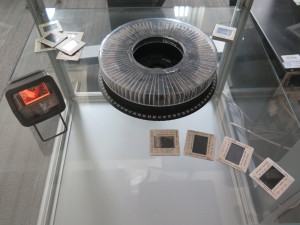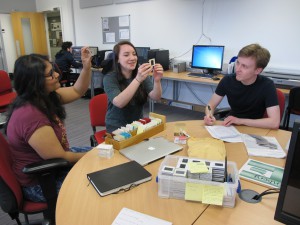
June 7, 2016, by Matt Davies
DHC Volunteer Projects 2016 part three: the Slide Librarians.
Readers of Digital Dialogues may be surprised that we house a slide collection in the Digital Humanities Centre but, whilst as a society we have often been quick to abandon the analogue for digital, there are many arguments for not being so hasty. Some of these arguments may be set forth in future blogs (see blog plans below) but in the meantime many Humanities students go on to seek work in archives, libraries or heritage institutions which look after analogue collections, so providing them with the opportunity to gain some experience with them seems like one good reason. Volunteers working with the collection learn how to handle and look after slides and operate associated viewing equipment; they learn about classification systems, ‘weeding’ processes, the planning, and workflows involved in digitising analogue collections and the complexities and ramifications of copyright and metadata.
The DHC Slide Collection.
Like the e-books and journals now widely used by students, the digital images that we take for granted and use for teaching, learning and research were, until relatively recently (mid noughties?) analogue; that is, real – existing outside the virtual world. Real books, real journals and, in the case of images, 35mm slides just like the ones of old family holidays that your parents –or grandparents -keep in the loft and occasionally inflict upon the family via a noisy projector (with an ominous burning smell) and a pop-up screen that no-one remembers how to assemble!
Arts and Humanities schools and departments at Universities built slide collections from the early decades of the twentieth century for teaching and research which were- and still are to varying extents -maintained by slide librarians. Like traditional librarians, we (for I was one) ordered, labelled and catalogued the slides as requested by teaching staff as well as offering help and advice to users of the collection. Sadly slide usage fell dramatically with the advent of online image searches, and collections fell into disuse, disrepair and sadly many have even been destroyed or are under serious threat.
Not so at Nottingham. The History of Art department’s slide collection which is well over 80,000 slides strong, travelled along with most of the University’s Humanities departments and accoutrements, to the new Humanities building in 2011. Here it found accommodation in what became the Digital Humanities Centre where the rather lovely purpose-built wooden cabinets which house the collection have become an integral part of the centre (quite literally to start with as they were used to divide the space!) and add a warmth and a counterpoint to the glass, plastic and steel of the digitisation equipment. The rich and varied collection of images therein also serves as a reminder that in DHC we are very much about the ‘Humanities’ as well as the ‘Digital’.
Student volunteers and slides.
However, the collection also serves a more immediate purpose. Whilst there is less call for them in teaching now, students working in DHC have always taken a strong interest in and enjoyed working with the collection; re-filing and repairing the slides, learning the –often quite eccentric –classification system(s) and simply enjoying the huge variety of images –a large percentage of which cannot be found online. One year’s volunteer team even set up the projectors and put on a show for members of the public during the university’s Mayfest open day. We also have slide scanners in DHC and whilst there are copyright restrictions and ramifications (another learning curve for volunteers) if scanned properly they make incredibly good digital images and faded, pink or blue slides can be brought back to vivid life using Photoshop which is available on a number of PCs in the centre. Moreover, there are whole sections of the collection to which the University owns copyright and which contain unique images which would be of great benefit digitised and made available for research. Watch this space for information on future projects to do just that!
The DHC Slide Librarian team 2015-17.
This year has seen an exceptional level of interest in the collection and in Tristan Goodfellow (Classical Civilisation), Sanchari Banerjee (English / History of Art) and Marina Phelps (History of Art) we have a whole team working on the slides whose members are bursting with ideas and enthusiasm. Their first major task has been to ‘weed’ a section of the collection; that is, using a system of priorities, ‘weed’ out poor quality duplicate slides so that we can create space and integrate the Classics department’s slide collection. This approximately 10,000 strong collection has been languishing in a filing cabinet in an office for a few years now and the team has decided that it needs to be made available for viewing, borrowing and potential digitisation projects ASAP!
Luckily all three members of the team are second year undergraduates and are keen to volunteer again in 2016-17 so continuing in their roles as Slide Librarians. Other ideas that they have include relabelling the drawers of the collection using colour schemes, reintroducing the long-lost searchable database of information about the slides available, promoting the collection to other Humanities students with displays and exhibitions (there is already a small display in the DHC’s display cabinet –come and check it out) and a series of blogs about the projects with regular features on favourite slides….
….again, watch this space!
No comments yet, fill out a comment to be the first



Leave a Reply